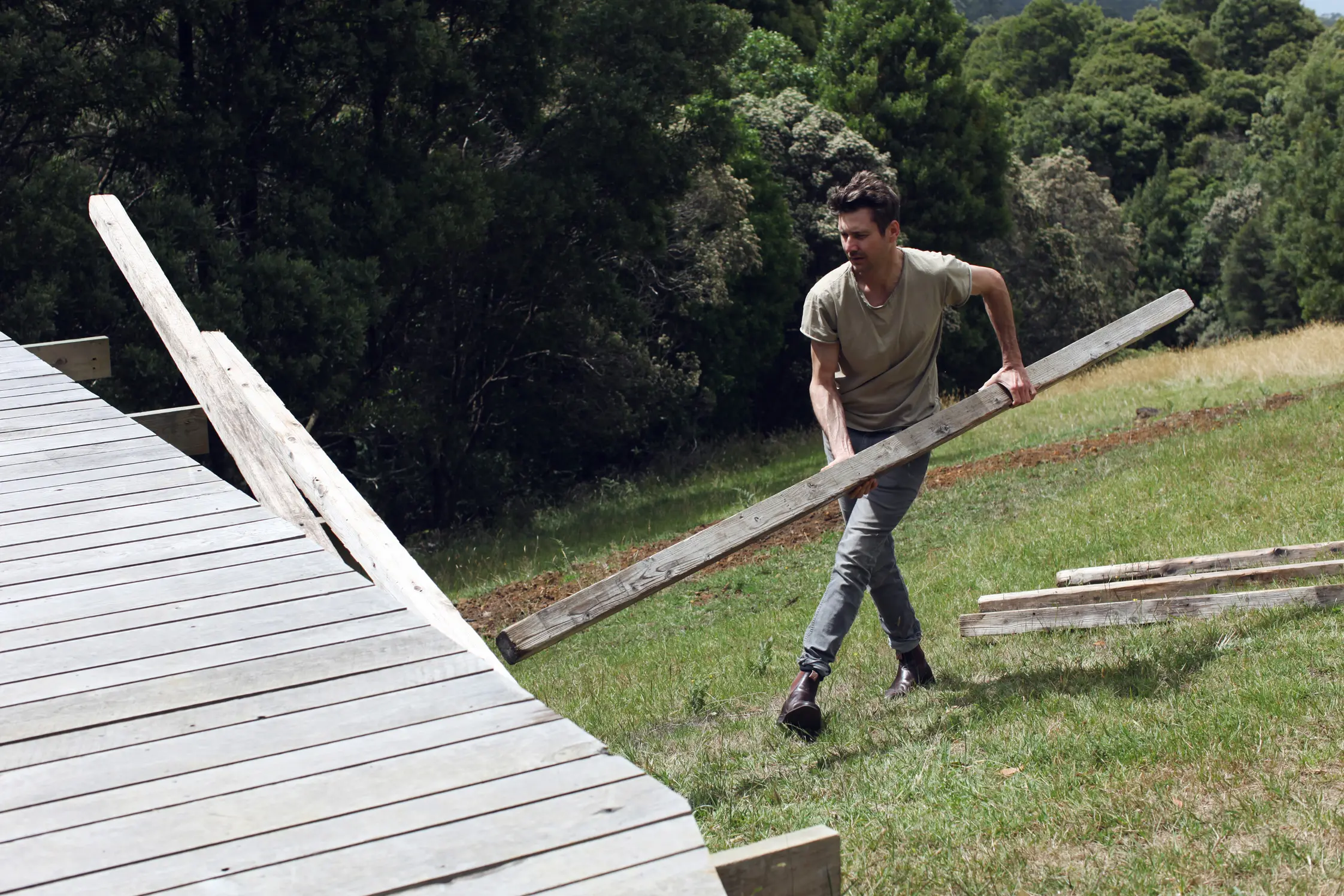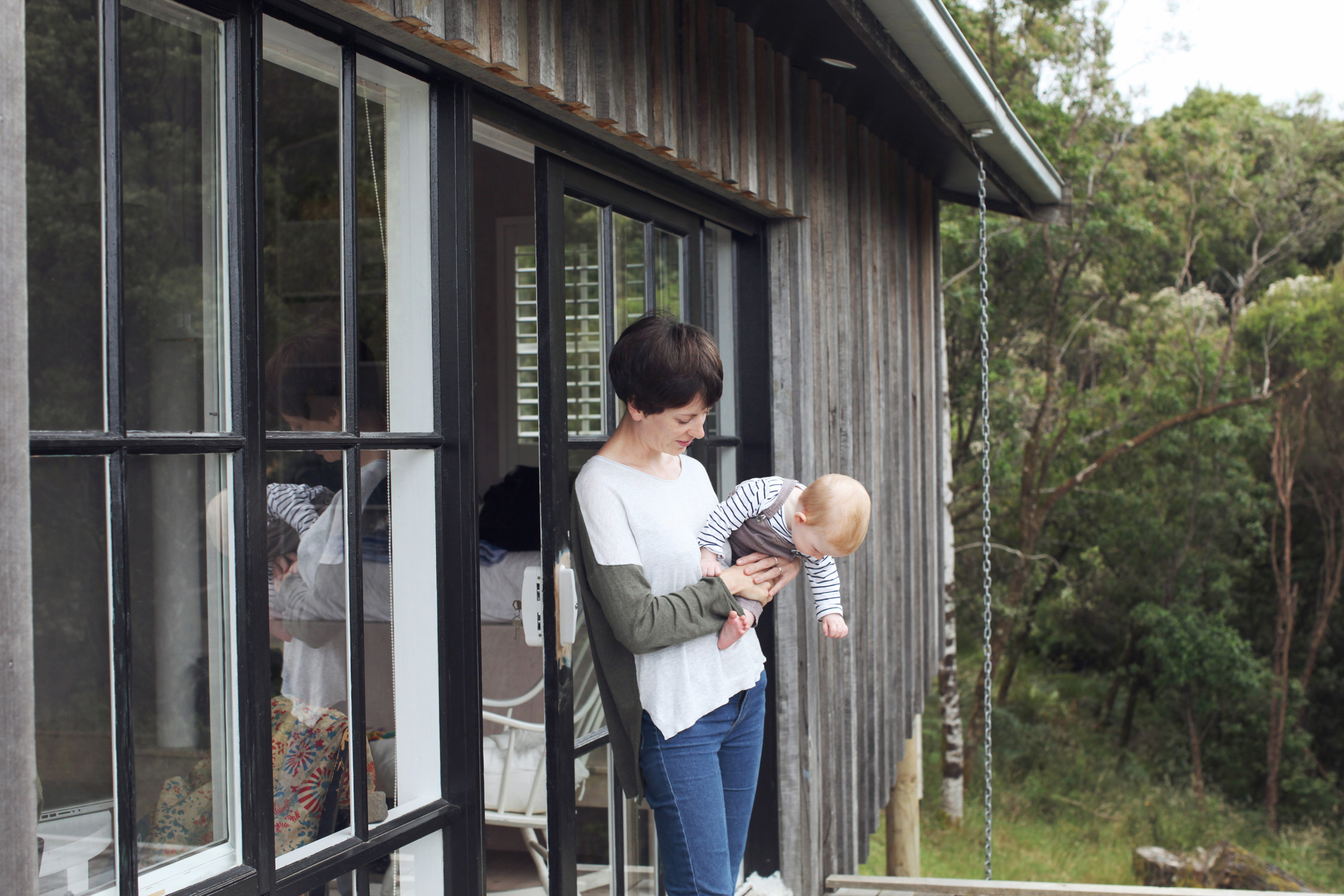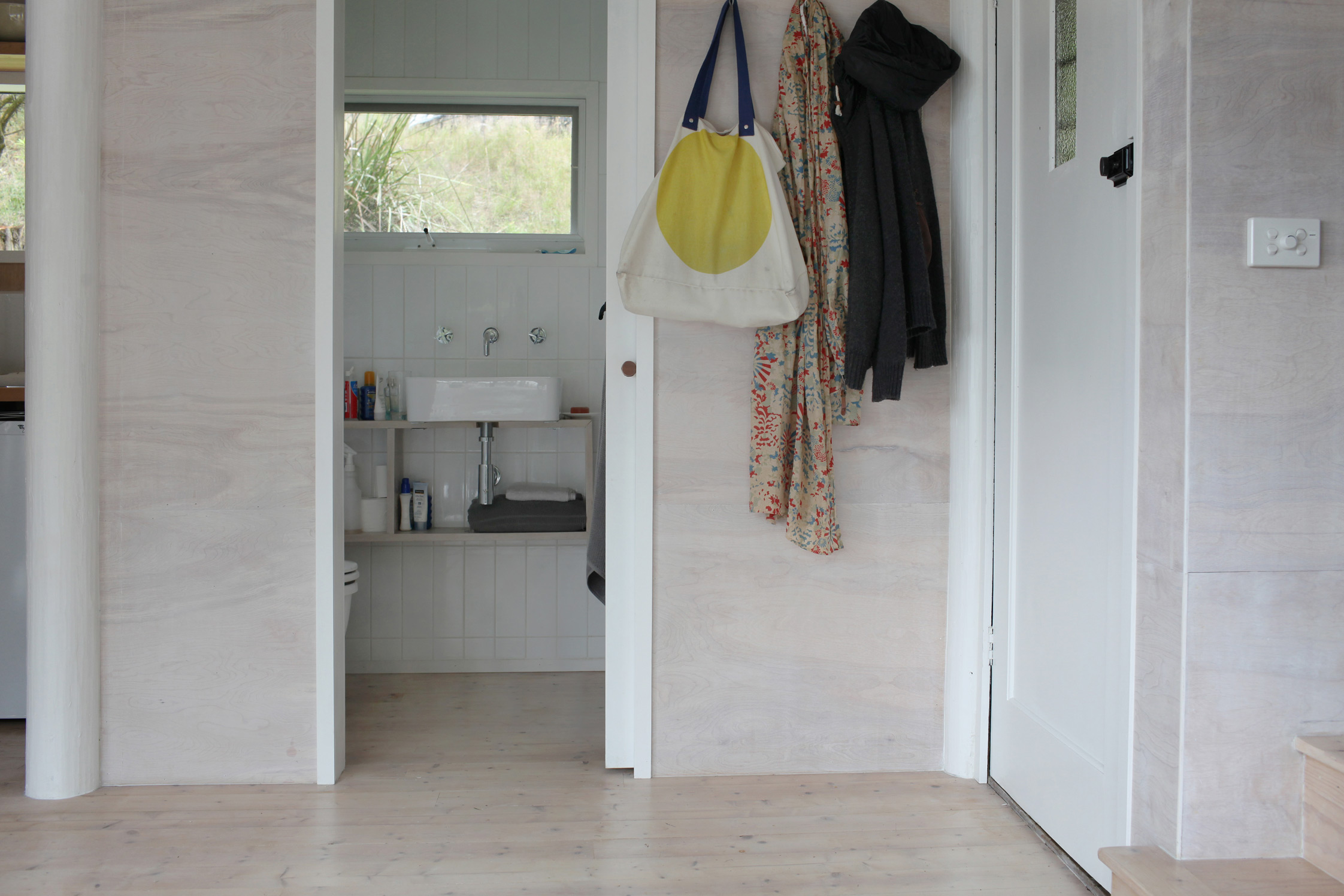On a quiet block, a few hours outside Melbourne, with an ocean view, perches The Humpy. The structure’s name comes from the indigenous Australian word for hut or shelter – apt for the small building, nestled in the trees. Summers in this part of the world are, well, summery. And winters are cozy – cold, misty days with clouds drifting through.
The cabin is built around an old derelict structure which formed the starting point of the project. But only the supporting posts, a few parts of the roof and the bearers remain, along with the black pot-bellied stove that provides ample warmth. Anthony Dann, architect and product designer, and his wife Phoebe, graphic designer, have spent the last two years of weekends slowly chipping away at the renovations. Most materials are recycled: the front door, floorboards and all windows. The timber cladding is sourced from a local timber miller, a one-man-band who sources and saws all his own wood. Even the ply that wraps the interior came from a pile of overs.
This desire to repurpose old materials was useful to keep costs down for Anthony and Phoebe, but it was also based on an idea that a building should be composed not just of the new, but of the old as well. That way, the design responds in an idiosyncratic way to what can be found and repurposed. The building services are all off-grid. Power is solar, the toilet is self-composting, rainwater is stored and pumped through and local firewood heats the house. We spoke to Anthony and Phoebe about the history of the project, their inspirations and the place of sustainability in daily life.
This portrait is part of our ongoing collaboration with ZEIT Online, who presents a special curation of our pictures on ZEIT Magazin Online.




-
What’s the story behind the shed?
The building is probably best described as a cabin rather than a shed. We live in central Melbourne, which is quite a big city, and wanted to build a small retreat to escape to. The idea was to keep it small and simple. At the time it was just us – no baby yet, so we were just thinking for two people. Now we have a one-year-old daughter, Fleur. For the coming couple of years it is fine, but we are planning to build a little pavilion bedroom before too long.
We found our opportunity on a six-hectare block of land in the Otway Ranges, two and a half hours from our home in central Melbourne. Our place has rolling grassland, forest and a little freshwater stream running through it. Large mobs of kangaroos live in the surrounding hills, and there is a view from the top of the ridge out towards the ocean, which is only a few winding kilometers away. There was an old shed on the site – a falling-down-thing we called “The Humpy.” It was tiny, only 4m x 4m, and was used occasionally by the owner, who was a surfer, hippy and traveller, but not much of a builder. It was full of spiders and god-knows-what-else and the floors were water-damaged and dangerous. We tore everything out, but we kept the bones of the structure, which gave us the starting point for our design. These “bones” were the timber posts which hold up the floor and roof, the floor beams and the pitched roof shape, which we felt was domestic and cozy. We built outwards, making the overall interior size 7m x 5.5m. It’s still little, but enough for a separate bathroom, a small kitchen with its own sense of place and a raised sleeping platform to give more dynamism to the space.
-
Have you lived in small spaces before?
We lived in a studio apartment in the center of Amsterdam for a few years, in a typical old canal house – a long single room with windows at either end. The only separate room was the bathroom. The kitchen was at one end with a courtyard view, and a bedroom area was separated from the eating area by a free-standing closet. At the other end was a beautiful, light living space with a view over the canal. The high ceilings and windows at either end were important features, and spaces could be cleverly defined with steps, lighting and furniture rather than walls. We learned from this time that small-space living could be extremely pleasant with the right proportions.



-
Did you look to other examples or projects on small space living?
Anthony: I had been fascinated by Le Corbusier’s Cabanon since university days. It is said to be an exemplar of good proportions in a tiny space, just 14m² (3.5m x 4m). Cabanon was a place for contemplation and private retreat, and the only building he made for himself. Like our cabin, it was also a plywood cocoon with furniture built-in where possible. Corb was said to have treasured Cabanon as his finest achievement – and the place he spent his last night alive, drowning the following day in the Mediterranean off Cap Martin in southern France.
The other major influencer was a houseboat I visited once in Amsterdam North. A friend and I were cycling past and stopped to knock on the door because we liked the look of it. It was a really sophisticated piece of architecture with split levels above and below the waterline and sweeping views from the wrapping glass walls. It was from this project that I got the sense that vertical dimension was important in planning small spaces.
-
Tell us something about the construction process – what materials did you use? How long did it take you?
Anthony: It was a long process! Working in the city, we could only use the odd weekend, so it took almost two years, and it required a lot of advance planning and organisation. It’s very remote down there, and an hour’s drive to the nearest hardware store. The building was done mainly by myself and Phoebe’s father. Neither of us have learned construction formally, but are keen amateurs, happiest to learn by doing. Building a house was an enticing step up.
“The Humpy” is made almost entirely of timber, plus corrugated iron for the smaller part of the exterior walls and the roof. A lot of materials were either reclaimed or second-hand, including the timber floorboards, roofing iron and all windows and doors. We also lucked out and stumbled upon an excess of plywood from a commercial building project, which we used for the interior. Using the original posts as a starting point meant that everything was a bit out of square, and each plywood panel had to meet perfectly, barely a millimeter tolerance, so hand-cutting them all was incredibly time-consuming. But is was worth it – now that it’s been limewashed along with the floor, it’s quite beautiful and very cozy.



-
What was your coolest find?
Anthony: There were a few, but one I especially liked, because of the process of sourcing it, was the native, rough-sawn, hardwood Victorian Ash timber we used for the cladding and decks. It was sourced by first getting to know a local surfer in the nearby town. He told me about this old timber miller, nicknamed Red for his red hair – a total character. His family had been in the town for generations and he even lived on a street named after his grandfather. We had tea with his wife and got a tour of the old timber mill, which he inherited and now operates single-handed. The hardest part of dealing with Red was that he would talk on and on literally for hours. It was as though we were the only people he’d seen all week. He was really old school and hopeless with phone-calls and texts. In the end, we finally got our wood delivered and it was thick, straight and very high quality.
The most important find in terms of the design was the window set, bought online from a renovated building site. These colonial timber frame windows gave us the opportunity to make a space that was a combination of openness to nature and enclosure, somewhere domestic and familiar. I had originally planned on doing the typical modern thing with big panels of floor-to-ceiling glass, giving no visual barrier between yourself and the nature surrounding you. However, once I saw these windows, I knew they could be used in such a way as to give ample transparency to the outside, but with the built-in character that a place of retreat and contemplation needs. After all, we don’t spend our whole time staring out at the view, but often live with our heads in a book, or spend time cooking a meal or drinking tea and sitting on the floor with our daughter. The space needed the comfort of the familiar.
-
How does the space you live in impact your work?
Phoebe: We both work in creative areas. I’m a graphic designer, and Anthony is an architect and furniture designer. Our weeks are busy and noisy with phone calls, client meetings, computer screens. Add to that the daily mayhem of our one-year-old, and by Friday evening we’re both cross-eyed and exhausted, so physical and emotional space is critical. Having the opportunity to completely unplug and leave it all behind for 48 hours is incredibly important to us. Such a small space – and a blissful lack of internet coverage – forces us to focus on ourselves and each other, rather than swiping through emails. All of this fuels our creative fires and come Monday morning we’re fresh, with new ideas or angles on projects we have. So, ironically, the space most important to our work is one we avoid working in.



-
What role does sustainability play in your everyday life?
Sustainability is something that we absolutely think about, and we do make choices based on it, although we aren’t dogmatic about it. It’s not really a sacrifice to act sustainably. Most of the time the real benefits come immediately – whether it’s cooking food grown organically or from our own hands, or getting some exercise by riding a bike instead of being stuck sitting in traffic. With “The Humpy,” it’s incredibly satisfying and liberating to be generating our own power, which costs nothing now that we own the equipment. And while we also enjoy the aesthetic of reused materials, it has mainly been important to us to use them in order to decrease the environmental impact of our little shed.
-
How can sustainable design contribute to local and global change?
Anthony: I am always hopeful that design can contribute to change. In a past life, I practiced as an industrial designer, working on products manufactured in cheap-labour countries. I often worked first-hand in these countries and factories, and saw the damage on the ground that almost nobody sees or thinks about when they buy goods cheaply. I wanted to run from this industry as fast as I could! In response, however, I decide to see how I could contribute from within, and started Paper Tiger, a furniture company which uses only recycled materials that are manufactured locally to the source of consumption. I see sustainable design as having a two-fold contribution to change. One, it provokes innovation throughout the entire manufacturing, production and distribution chain, and thought and consideration in the end user. And two, it does so with minimal impact itself.
-
What do you think about sustainability as a lifestyle trend?
Anthony: I think that true sustainability has nothing to do with lifestyle, but with simple decision making. We are faced with so much choice now, and choosing one product or service over another is the simplest, easiest way to live sustainably. It might cost more, but it often costs less, and it is the ultimate pathway for change in a market economy. As long as our government encourages competition and growth in alternatives, the public will be able to move towards better outcomes without any pain. We should really have rules to ensure that making money doesn’t harm others or the planet. That’s where government needs to act with strength and be free from corporate influence – which is probably the biggest challenge.


Thank you, Anthony and Phoebe, for showing us around your home and sparking our imaginations about sustainable living.
More information about Anthony’s furniture company, Paper Tiger, is available on their website.
Also, check out more of Anthony’s and Phoebe’s creative peers in our portraits from Melbourne.
Interview & Photos:Astrid Salomon

